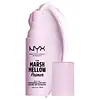What's inside
What's inside
 Key Ingredients
Key Ingredients

 Benefits
Benefits

 Concerns
Concerns

No concerns
 Ingredients Side-by-side
Ingredients Side-by-side

Water
Skin ConditioningGlycerin
HumectantSodium Acrylates Crosspolymer-2
AbsorbentButylene Glycol
HumectantDipropylene Glycol
Humectant1,2-Hexanediol
Skin ConditioningC12-14 Pareth-12
EmulsifyingAmmonium Acryloyldimethyltaurate/Vp Copolymer
Carbomer
Emulsion StabilisingCaprylyl Glycol
EmollientArginine
MaskingEthylhexylglycerin
Skin ConditioningHydroxypropyl Methylcellulose Stearoxy Ether
Silybum Marianum Extract
Skin ConditioningTocopherol
AntioxidantCI 17200
Cosmetic ColorantWater, Glycerin, Sodium Acrylates Crosspolymer-2, Butylene Glycol, Dipropylene Glycol, 1,2-Hexanediol, C12-14 Pareth-12, Ammonium Acryloyldimethyltaurate/Vp Copolymer, Carbomer, Caprylyl Glycol, Arginine, Ethylhexylglycerin, Hydroxypropyl Methylcellulose Stearoxy Ether, Silybum Marianum Extract, Tocopherol, CI 17200
Water
Skin ConditioningButylene Glycol
HumectantGlycerin
HumectantButyrospermum Parkii Butter
Skin ConditioningDecyl Cocoate
EmollientPolyglyceryl-3 Methylglucose Distearate
EmulsifyingCaprylyl Methicone
Skin ConditioningDicaprylyl Carbonate
EmollientDi-C12-13 Alkyl Malate
Emollient1,2-Hexanediol
Skin ConditioningPolymethylsilsesquioxane
Althaea Officinalis Root Extract
Skin ConditioningChlorella Vulgaris Extract
Skin ConditioningStearic Acid
CleansingPotassium Cetyl Phosphate
EmulsifyingSorbitan Sesquioleate
EmulsifyingCarbomer
Emulsion StabilisingGlucose
HumectantFructooligosaccharides
HumectantFructose
HumectantGlyceryl Caprylate
EmollientTriethoxycaprylylsilane
Sodium Polyacrylate
AbsorbentSodium Polyacrylate Starch
AbsorbentPalmitic Acid
EmollientTromethamine
BufferingAluminum Hydroxide
EmollientCitric Acid
BufferingTrisodium Ethylenediamine Disuccinate
Xanthan Gum
EmulsifyingSynthetic Fluorphlogopite
Ethylhexylglycerin
Skin ConditioningPolyglyceryl-2 Diisostearate
EmulsifyingCetyl Alcohol
EmollientTocopherol
AntioxidantTocopheryl Acetate
AntioxidantPhenoxyethanol
PreservativeCI 77491
Cosmetic ColorantCI 77891
Cosmetic ColorantParfum
MaskingWater, Butylene Glycol, Glycerin, Butyrospermum Parkii Butter, Decyl Cocoate, Polyglyceryl-3 Methylglucose Distearate, Caprylyl Methicone, Dicaprylyl Carbonate, Di-C12-13 Alkyl Malate, 1,2-Hexanediol, Polymethylsilsesquioxane, Althaea Officinalis Root Extract, Chlorella Vulgaris Extract, Stearic Acid, Potassium Cetyl Phosphate, Sorbitan Sesquioleate, Carbomer, Glucose, Fructooligosaccharides, Fructose, Glyceryl Caprylate, Triethoxycaprylylsilane, Sodium Polyacrylate, Sodium Polyacrylate Starch, Palmitic Acid, Tromethamine, Aluminum Hydroxide, Citric Acid, Trisodium Ethylenediamine Disuccinate, Xanthan Gum, Synthetic Fluorphlogopite, Ethylhexylglycerin, Polyglyceryl-2 Diisostearate, Cetyl Alcohol, Tocopherol, Tocopheryl Acetate, Phenoxyethanol, CI 77491, CI 77891, Parfum
Ingredients Explained
These ingredients are found in both products.
Ingredients higher up in an ingredient list are typically present in a larger amount.
1,2-Hexanediol is a synthetic liquid and another multi-functional powerhouse.
It is a:
- Humectant, drawing moisture into the skin
- Emollient, helping to soften skin
- Solvent, dispersing and stabilizing formulas
- Preservative booster, enhancing the antimicrobial activity of other preservatives
Butylene Glycol (or BG) is used within cosmetic products for a few different reasons:
Overall, Butylene Glycol is a safe and well-rounded ingredient that works well with other ingredients.
Though this ingredient works well with most skin types, some people with sensitive skin may experience a reaction such as allergic rashes, closed comedones, or itchiness.
Learn more about Butylene GlycolCarbomer is a polymer of acrylic acid. Its main role is to create a gel consistency.
A high amount of carbomer can cause pilling or balling up of products. Don't worry, most products contain 1% or less of carbomer.
Ethylhexylglycerin (we can't pronounce this either) is commonly used as a preservative and skin softener. It is derived from glyceryl.
You might see Ethylhexylglycerin often paired with other preservatives such as phenoxyethanol. Ethylhexylglycerin has been found to increase the effectiveness of these other preservatives.
Glycerin is already naturally found in your skin. It helps moisturize and protect your skin.
A study from 2016 found glycerin to be more effective as a humectant than AHAs and hyaluronic acid.
As a humectant, it helps the skin stay hydrated by pulling moisture to your skin. The low molecular weight of glycerin allows it to pull moisture into the deeper layers of your skin.
Hydrated skin improves your skin barrier; Your skin barrier helps protect against irritants and bacteria.
Glycerin has also been found to have antimicrobial and antiviral properties. Due to these properties, glycerin is often used in wound and burn treatments.
In cosmetics, glycerin is usually derived from plants such as soybean or palm. However, it can also be sourced from animals, such as tallow or animal fat.
This ingredient is organic, colorless, odorless, and non-toxic.
Glycerin is the name for this ingredient in American English. British English uses Glycerol/Glycerine.
Learn more about GlycerinTocopherol (also known as Vitamin E) is a common antioxidant used to help protect the skin from free-radicals and strengthen the skin barrier. It's also fat soluble - this means our skin is great at absorbing it.
Vitamin E also helps keep your natural skin lipids healthy. Your lipid skin barrier naturally consists of lipids, ceramides, and fatty acids. Vitamin E offers extra protection for your skin’s lipid barrier, keeping your skin healthy and nourished.
Another benefit is a bit of UV protection. Vitamin E helps reduce the damage caused by UVB rays. (It should not replace your sunscreen). Combining it with Vitamin C can decrease sunburned cells and hyperpigmentation after UV exposure.
You might have noticed Vitamin E + C often paired together. This is because it is great at stabilizing Vitamin C. Using the two together helps increase the effectiveness of both ingredients.
There are often claims that Vitamin E can reduce/prevent scarring, but these claims haven't been confirmed by scientific research.
Learn more about TocopherolWater. It's the most common cosmetic ingredient of all. You'll usually see it at the top of ingredient lists, meaning that it makes up the largest part of the product.
So why is it so popular? Water most often acts as a solvent - this means that it helps dissolve other ingredients into the formulation.
You'll also recognize water as that liquid we all need to stay alive. If you see this, drink a glass of water. Stay hydrated!
Learn more about Water